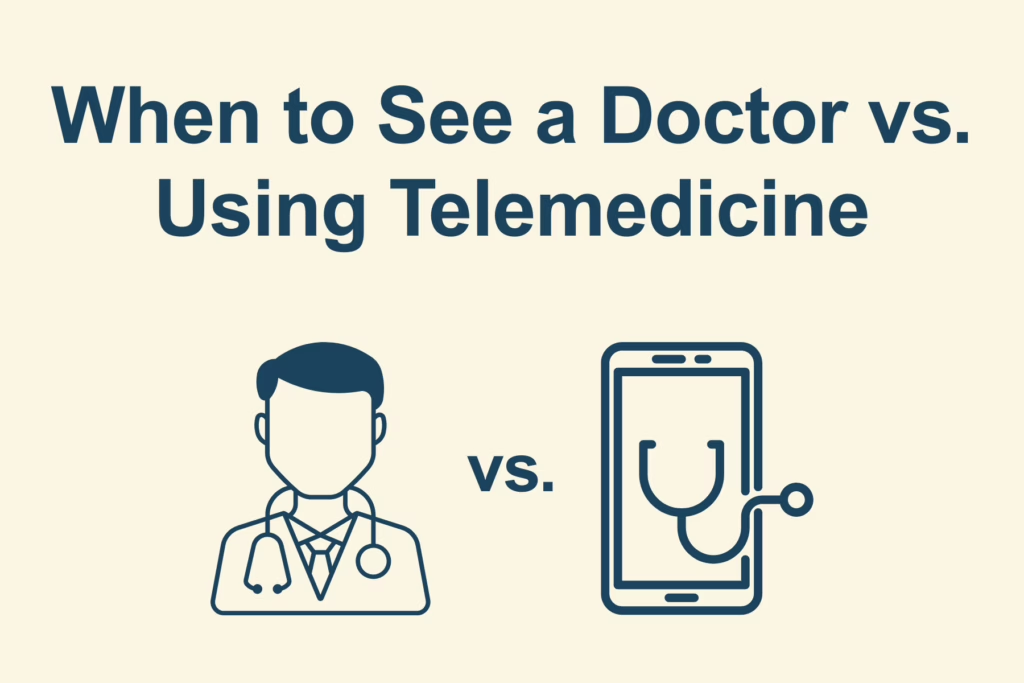Getting medical care is easier today than ever before. Thanks to telemedicine, people can now talk to healthcare providers without ever leaving their homes. However, telemedicine may not always be the right answer in some situations. So, how do you know when you should use telemedicine, or when to see a doctor instead?
In this article, we’ll share the differences in these two options so you can determine when to see a doctor in person, rather than getting a telehealth appointment.
What is Telemedicine?
If you aren’t familiar, telemedicine is the ability to connect with a doctor, nurse practitioner, or other licensed medical provider through technology. These appointments usually take place through video call, phone call, or a secure messaging app. Rather than sitting in a waiting room, this option gives patients the ability to get professional care from the comfort of their homes.
Telehealth appointments have grown in popularity due to their convenience, cost-effectiveness, and speed to access a provider. They’re also an excellent option for those with limited transportation or mobility.
When to Use Telemedicine
There are many situations in which telemedicine is the best option. Some situations in which telehealth can be helpful include:
- Minor colds or flu-like symptoms
- Rashes, acne, or other skin conditions
- Urinary tract infections
- Medication refills or dosage adjustments
- Mental health check-ins
- Follow-up visits
- Reviewing test results
For example, if you’ve developed a mild cough but no other concerning symptoms, a telemedicine appointment can give peace of mind, as well as a potential prescription for medication, all without having to go to the clinic.
As with any appointment, be sure you’re prepared for your telehealth visit. Write down all your symptoms and have a list of medications and your health insurance card handy.
When to See a Doctor In Person
Though telemedicine is helpful, there may be times when a hands-on approach is required. Knowing when to see a doctor in person is key to getting the care you need.
Some situations where you will need to see a doctor in person include:
- Severe or persistent pain, especially in the chest, abdomen, or head
- Shortness of breath or difficulty breathing
- High fever that doesn’t go down after a few days
- Signs of infection, like redness, swelling, or pus
- Digestive problems like vomiting, diarrhea, or bloody stool
- Dizziness, fainting, or confusion
- Injuries that may require X-rays or stitches
- Abnormal lumps or swelling that need a physical exam
In these cases, a physical examination, tests, or other hands-on treatment may be necessary, so going to the doctor is essential to get the care you need.
Red Flags To Not Ignore
- Certain symptoms require urgent medical attention, either at a clinic or an emergency room. Don’t hesitate to seek emergency medical care if you experience:
- Chest pain or pressure, especially if it radiates to your arm or jaw
- Trouble breathing or wheezing
- Severe allergic reactions, like swelling of the throat
- Sudden vision changes or difficulty speaking
- Weakness on one side of the body
- Uncontrolled bleeding or signs of internal injury
- Thoughts of self-harm or suicide
If you are experiencing any of these symptoms, it’s time to put away telehealth and call 911 or go directly to the nearest emergency room. These situations are clear examples of when to see a doctor without delay.
Combining Telehealth With Doctor Visits
In some cases, you may be able to do a combination of telehealth and in-person visits to the doctor. This often results from a telehealth visit in which the doctor wants to do a further examination.
For example, you may seek a telehealth appointment for a skin rash, but may need to go in for testing if it doesn’t resolve quickly. Recurring symptoms like chronic migraines, worsening infections, or minor injuries may also require a transition from telemedicine to a physical examination. Knowing when to see a doctor is key to making sure your health is treated appropriately.
How to Decide When to See a Doctor
If you’re not sure if you should schedule a telemedicine appointment or see a doctor in person, ask yourself these questions to guide your choice:
- Can I describe my symptoms clearly without being examined?
If yes, telemedicine might be a good first step.
- Am I in severe pain or experiencing something unusual or alarming?
If yes, that’s a strong sign of when to see a doctor face-to-face.
- Do I need tests, lab work, or imaging?
These usually require an in-person visit.
- Is this a follow-up for a condition that was already diagnosed?
Depending on the condition, telehealth can likely handle this just fine.
- Do I feel like something is seriously wrong or getting worse?
Trust your gut, this may be when to see a doctor without delay.
Use these questions as a checklist to determine which type of healthcare visit is best for you.
Making the Right Choice for Your Health
There’s no simple answer when it comes to choosing a type of healthcare visit. Both telemedicine and in-person visits have their place in modern healthcare, but the key difference is the type of services offered in both. Though telemedicine is helpful for mild conditions and prescriptions, seeing a doctor in person is often a better choice for more severe illness or injury.
If something feels serious or you’re struggling to explain your symptoms through a video call, that’s exactly when to see a doctor face-to-face.
Final Thoughts: Do What’s Right For You
Telemedicine and traditional care are partners in your healthcare journey. While one offers convenience, the other offers hands-on support for more severe health issues. Together, they offer greater flexibility and accessibility to staying healthy than ever before.
At All Family Pharma, we’re all about making informed healthcare choices. If you’re looking for guidance on your health, browse our shop of supplements or speak to one of our licensed physicians today.




